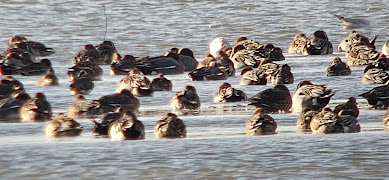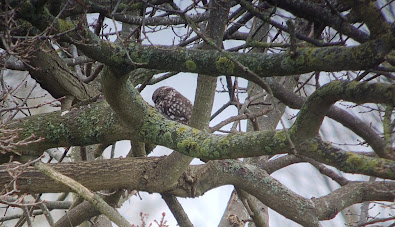With the Vale of York fog-bound, I took a gamble to head for the hills, or the Moors to be precise. The North York Moors are only an hour north of York and much is heavily-degraded driven grouse moors, all burnt to within a few inches of their life, to promote the growth of young heather, for the Red Grouse to eat. Raptor persecution is rife along with wholesale industrial slaughter of every other potential predator of grouse chicks. This is all to enable moor owners to offer large 'bags' of grouse, to tempt rich punters to part with lots of cash for a days blasting birds out of the sky. All very depressing.
As I headed up through Hutton-le-Hole, the cloud was still very low and I began to feel I had been a little too optimistic! However, to my relief, as I broke the ridge and descended Rosedale Chimney, I could see clear skies to the north of the village. Fingers crossed!
Mark Fewster, Nick Addey and Chris Bell were all in position when I arrived on the moor; they hadn't seen any Rough-legged Buzzards but had had a mouth-watering haul of raptors, which boded well. A pair of Ravens cronked past within minutes; not a common bird on the NYM, so this was a good start. Golden Plovers were bombing about and there were plenty of Red Grouse strutting their stuff. Shortly, Mark headed off, followed a little later by Nick and Chris though not before a Peregrine cruised south along the ridge in front of us. Shortly, a Hen Harrier - a ringtail- appeared over the ridge and quartered it's way north across the moor and into the distance, flushing coveys of grouse and fast-flying Goldies.
After a while I noticed a raptor sitting on a stone post on the far ridge. To my surprise, zooming up it seemed to be a young Goshawk! Even at long range, the upright stance, long tail and comparatively small head on a long body was distinctive. But what was it doing out here? Cropton Forest was only a mile or so away, so perhaps they do come up here, hunting plovers and other small birds.
Another birder arrived and I pointed the bird out; he wasn't convinced, but it was a long way off. I kept my eye on it, feeling that if it flew, I could nail it. To my surprise, another raptor came gliding over the ridge not far from the Gos and down the slope towards us. It was clearly a buzzard sp. and seemed pale-headed. I suggested the other birder get on the bird; it then swooped on to a large boulder, revealing a big solid black belly patch contrasting beautifully with a straw-coloured breast and head. A Rough-leg! Just then the other bird took flight and headed off low across the moor, confirming itself as a Gos.
The Rough-leg was pretty distant and after 20 minutes of watching it, the other birder told me there was a track close-by which would allow us to get 500m closer. I headed down there, followed by the other guy. It did seem a lot closer, but the bird was still pretty distant, allowing us to watch it without disturbance.

As I was watching it, Nick rang to say they had found another Rough-leg and could also see 'our' bird in the distance. Unfortunately, their bird was out of sight for me, but our bird was good enough. After my temporary companion departed, another birder turned up and we spent the next couple of hours following the Rough-leg as it boulder-hopped up the valley. The moor was very still, with little breeze, which perhaps was causing the bird to hunt in this manner. There was certainly no wind to aid hovering, which is often employed by Rough-legs. Much of this area of Rosedale Moor is heavily managed for grouse, but the steep slopes and narrow valley of Northdale Rigg has a mix of rough grass, scrub and woodland, along with the heather moorland above, and it is perhaps this mix that is attracting the raptors, presumably hunting voles, birds and rabbits.
The Rough-leg never came close until right at the death, when having reached the top of the valley, it decided to fly back down towards Rosedale, giving great views as it passed along the rigg in front of us. Nearby, a Merlin was perched up on a rock and we saw a Peregrine again, the female Hen Harrier and two or three Common Buzzards. Havings seen Sparrowhawk and Kestrel on my way up, this had become an unexpected eight raptor day! With Marsh Harrier and Red Kite easy to see back near York, I was tempted to head down the LDV to complete the set, but in the end decided to quit while I was ahead and go back for a celebratory cuppa. As I headed back down towards Rosedale village, a Barn Owl was perched on a gate next to the road. Perfect! To see this many raptors on a small part of the North York Moors demonstrates what the area could support if only some of the gamekeepers would be more tolerant of birds of prey (and not break the law) and would allow a more natural mosaic of upland habitats to develop.

A tiny Merlin - honest!
Distant Rough-leg footage.















































